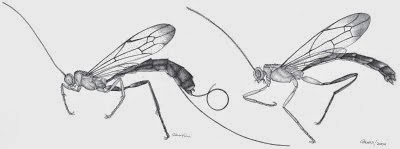Ichneumon Wasps are parasitoids whose larvae develop on or in the
bodies of other Arthropods, typically Insects or Spiders. Since Insect species
are always described from adult specimens, species of parasitoid Wasps are
generally named from specimens taken from the wild as adults, and the larval
host of often unknown. However some scientists have developed an alternative
method, in which members of host species infected with larval wasps are found,
then kept in captivity as the larvae develops into an adult.
In a paper published in the journal Zootaxa on 11 December 2014,
Niclas Fritzén of the Zoological Museum and Department of Biology at the Universityof Turku described two new species of Ichneumon Wasps from specimens reared
from larvae living on Theridiid Spiders collected in Fennoscandia (Finland plus
Scandinavia) and Hungary. Both the Wasps belong to the Polysphincta genus-group in which the larval Wasp develops as an
ectoparasite, on the outside of the hosts body, making them particularly
suitable for this method, as it is possible to detect infection with a simple
visual inspection.
The first new species described is placed in the genus Flacopimpla, and given the specific name
barathrica, in reference to the
habitat where it was found, in caves rock clefts or similar spaces on manmade
structures; the Barathrum was a pit in ancient Athens into which criminals were
cast. The species is described from specimens raised from larvae found growing
on Spiders of the species Thymoites
bellissimus, collected from caves and rock clefts in Finland, Norway and
Sweden, from pupae found in or close to the webs of the same species of
Spiders, and from a single specimen adult specimen from a Malaise trap (expand)
in a Pine forest in Sweden , though Fritzén notes that this wild-caught adult
specimen had swellings on either side of its thorax not seen in any other
specimens, making its taxonomic status slightly uncertain.
Flacopimpla
barathrica in lateral view (slightly straightened)
and head in anterior view. Fritzén (2014).
Adult wasps range from 3.6-5 mm in length in females and 3.0-4.5 mm
in males. All are dark brown with pale legs. Larvae seemed to orientate
themselves predominantly with their heads orientated towards the rear of the
spider, though three (of 31 examined) were orientated the other way round.
Pupae were loosely woven and spongy in appearance, and frequently (~60% of the
time) infested with the larvae of the pseudohyperparasitoid (expand) Ichneumon
Wasps Gelis sp.
(7) An adult female of the host Thymoites bellissimus with the larva of Flacopimpla barathrica.(8) A subadult male of the same host species
infested with both the larva of Flacopimpla
barathricaand an Iphidosoma
physogastris Mite. (9) Cocoon with pupa in situ (Oulanka National Park), attached
to the upper rock surface in the web of the host. (10) The newly emerged
holotype in vitro, still resting on the cocoon. Scale bars 1 mm. Fritzén (2014).
This is the first species of Flacopimpla to
be described from Europe; all previously known species have come from North and
Central America. It is also the first known species of the genus to inhabit
caves, and while it cannot be considered a true deep cave dweller, living in
the dark zones of cave systems away from sunlight, it does live far enough in
to be inhabiting a distinct micro-climate, more stable (i.e. less prone to
extremes of temperature or strong fluctuations in temperature) than that of the
surrounding boreal forests. The host species, Thymoites bellissimus, is found in boreal forests across the Arctic
Circle, so it is likely that Flacopimpla
barathrica is also more widely distributed than has been discovered to
date; in particular it was found in Finland close to the border with Russia,
and it is highly likely that it extends at least some way into Russian
territory.
The first location where Flacopimpla barathrica was first discovered, in the Pirunpesä
ravine in Kuopio, Finland. Fritzén (2014).
The second new species described is placed in the genus Zatypota, and given the specific name flamma, meaning ‘flame’, in reference to
the colour of the adult. The species is described from a single female specimen
raised from a Spider of the genus Parasteatoda,
probably Parasteatoda lunata, found
in mixed Beech/Oak woodland in Brennbergbánya in northwest Hungary. The
specimen is 3.7 mm in length and brown and yellow in colour.
Zatypota flamma in lateral view (slightly straightened) and head in anterior view. Fritzén
(2014).
Members of the genus Zatypota has
previously been recorded from Europe, Asia, North America and Central America.
Zatypota flamma. (11) The cocoon and (12–13) the larva on its host Parasteatoda?lunata. Scale bars 1 mm.Fritzén (2014).
See also…
 Two new species of Ichneumon Wasps from Africa. Ichneumon Wasps are large parasitoid Wasps (the largest species can
exceed 5 cm) closely related to Braconids. They are noted for their
reproductive behaviour, in which the females sting another Insect or...
Two new species of Ichneumon Wasps from Africa. Ichneumon Wasps are large parasitoid Wasps (the largest species can
exceed 5 cm) closely related to Braconids. They are noted for their
reproductive behaviour, in which the females sting another Insect or... Ichneumon Wasps are a group of highly specialized...
Follow Sciency Thoughts on Facebook.







